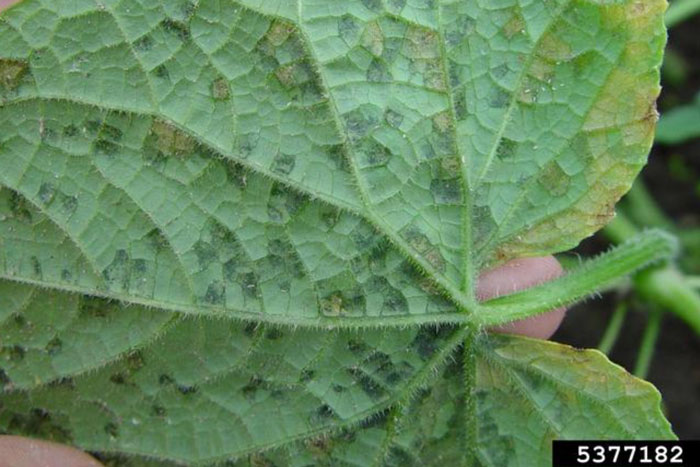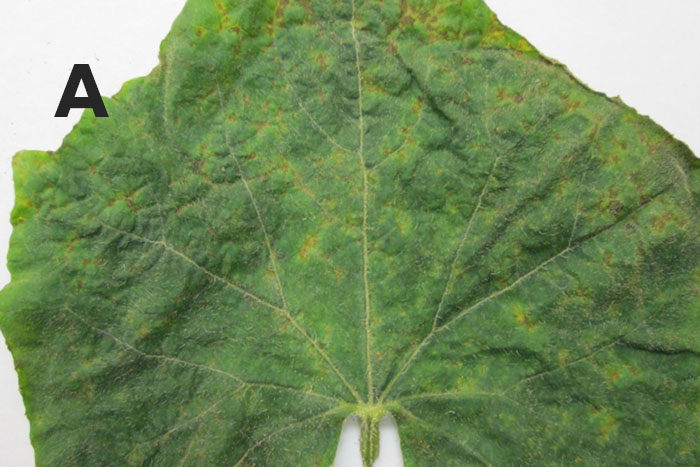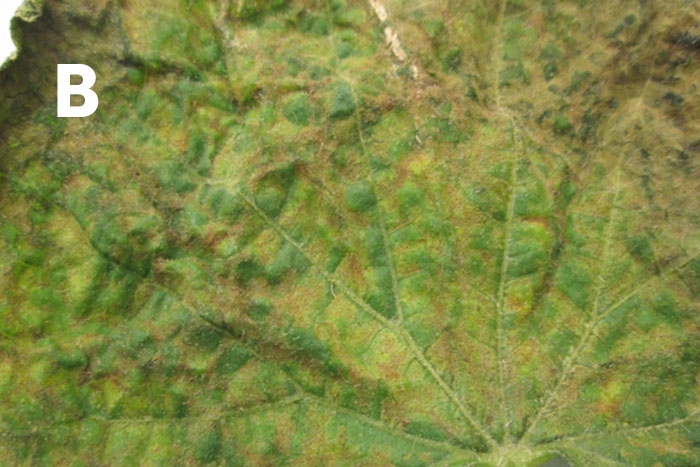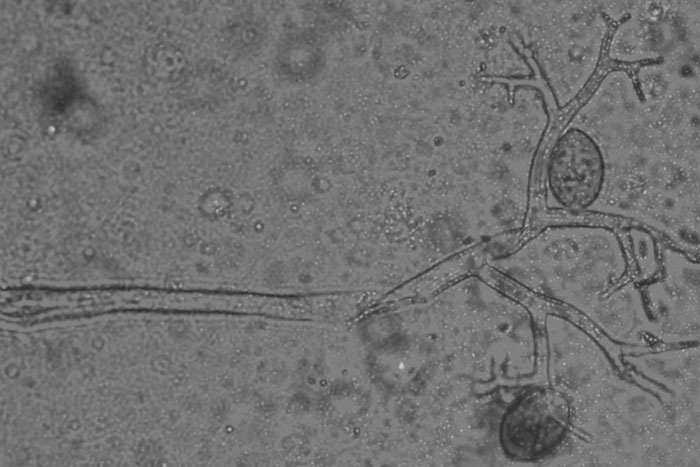Taking an environmentally sensitive approach to pest management
Cucumber Downy Mildew
Published: August 23, 2019
Cucumber downy mildew caused by the fungus-like organism Pseudoperonospora cubensis was confirmed recently on a cucumber plant from Morgan County, MO by the University of Missouri Plant Diagnostic Clinic. Downy mildew is primarily a disease of the Cucurbitaceae family including cucumber, watermelon, cantaloupe, gourds, squash and pumpkin. Downy mildew affects mostly the leaves, however, vine defoliation can cause yield reduction and impact fruit quality. This disease can be devastating on crops in the years when it occurs.

Figure 1 Initial water soaked symptom of downy mildew on the underside of cucumber leaf. (Photo by Gerald Holmes, California Polytechnic State University at San Luis Obispo, Bugwood.org)
Symptoms and signs
Depending on the plant species affected, downy mildew presents varying disease symptoms on plants. On cucumber, initial symptoms appear as water-soaked lesions on the lower leaf surface during periods of leaf wetness (Figure 1), and irregularly shaped chlorotic lesions that are vein bound appear on the upper leaf surface (Figure 2).


Figure 2 Symptoms of downy mildew caused by P. cubensis on the upper surface of cucumber leaf. Initial chlorotic lesion symptom (A), irregularly shaped vein-bound chlorotic lesion (B). (Photo by Josephine Mgbechi-Ezeri)

Figure 3 Cucumber leaf showing large area of necrotic lesion at the later stage of downy mildew infection. (Photo by Josephine Mgbechi-Ezeri).
As the disease progresses, the lesions may coalesce with large area of the leaf tissue turning necrotic and eventual death of the leaves (Figure 3). One of the key diagnostic features of downy mildew infection is the presence of purple-gray colored fuzzy growth with sporangia and sporangiophores observed on the underside of the leaves after early morning dews or rainfall. An additional diagnostic feature is the lemon shaped sporangia and dichotomously branched sporangiophores observed under the microscope (Figure 4).

Figure 4 Lemon-shaped sporangia and the dichotomously branched sporangiophore of P. cubensis under the microscope. (Photo by Josephine Mgbechi-Ezeri).
Disease cycle
Pseudoperonospora cubensis,a water mold within the class Oomycetes, is an obligate parasite. The pathogen does not overwinter in infected plant debris. It requires living plant tissue to survive in areas with mild winter weather or in protected greenhouses or tunnels, and cannot survive typical winter conditions in the Midwest. Spores are blown in by wind from southern states or inoculum is introduced from infected transplant materials. Downy mildew spores arrive in the Midwest region in mid-July, late in the growing season, and in some years may not be an issue. Downy mildew disease development is favored by high humidity, prolonged periods of leaf wetness (6 to 12 hr) and moderate temperatures between 59°F and 68°F. Depending on the temperature and moisture level at the time of infection, sporangia production occurs in 4-12 days and disease symptoms can be observed 3-12 days after infection. The extreme wet conditions experienced in Missouri this year from May to July favored the development of this disease in this growing season. Downy mildew affects various crop species, however, the pathogen is host specific. There are several pathotypes and strains of P. cubensis within the pathotypes that infect cucurbits. Cucumber and cantaloupe are susceptible to all pathotypes whereas other cucurbits such as watermelon, pumpkin are host specific.
Disease management
Effective management of downy mildew requires an integrated pest management approach which includes cultural practices, use of resistant varieties and fungicide application. Cultural practices for prevention focus on reducing period of leaf wetness including early planting, selecting sites with good air circulation, increasing planting space, avoiding overhead irrigation and increasing air circulation within the canopy by trellising. Use of resistant varieties can delay disease onset by suppressing sporangia production by the pathogen and reducing disease inoculum. Information on cucumber varieties with some level of resistance to downy mildew can be obtained from Cornell University: http://vegetablemdonline.ppath.cornell.edu/Tables/TableList.htm
Chemical applications can be used in combination with other management practices for the control of downy mildew pathogen. Due to strains of P.cubensis developing fungicide resistance, use of fungicides such as mefenoxam, metalaxyl and the strobilurin (Cabrio, Flint, Merivon, Pristine, Quadris, Reason and Satori) has been discontinued. Fungicides listed for the control of downy mildew include Elumin®, Forum®, Gavel®, Orondis Opti®, Orondis Gold®, Orondis Ultra®, Ranman®, Zampro® and Zing®.
For more detailed information on products and recommended rates of application visit these publications:
- The Midwest Vegetable Production Guide for Commercial Growers 2019
https://ag.purdue.edu/btny/midwest-vegetable-guide/Documents/2019/ID-56_2019.pdf#page=120 - Extension fact sheet on cucurbit downy mildew by Purdue University
https://www.extension.purdue.edu/extmedia/BP/BP-140-W.pdf
Subscribe to receive similar articles sent directly to your inbox!
REVISED: August 23, 2019